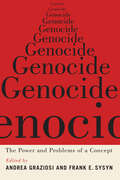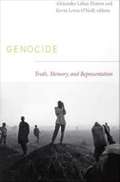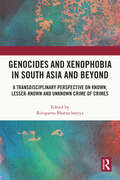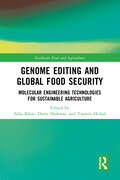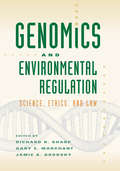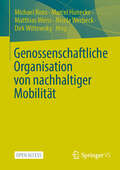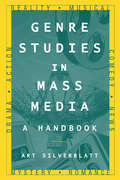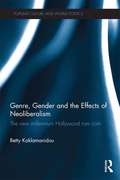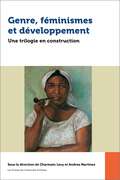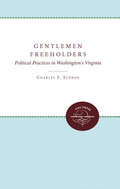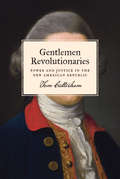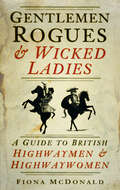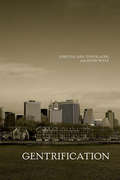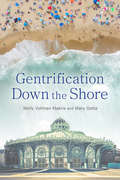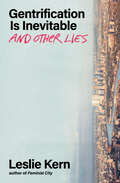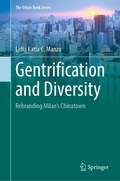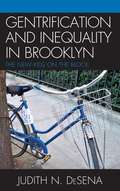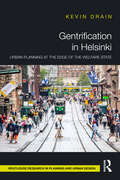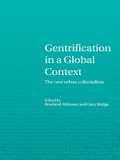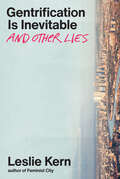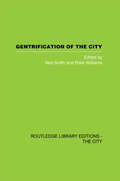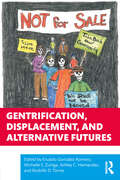- Table View
- List View
Genocide: The Power and Problems of a Concept
by Andrea Graziosi and Frank E. SysynSince the 1980s the study of genocide has exploded, both historically and geographically, to encompass earlier epochs, other continents, and new cases. The concept of genocide has proved its worth, but that expansion has also compounded the tensions between a rigid legal concept and the manifold realities researchers have discovered. The legal and political benefits that accompany genocide status have also reduced complex discussions of historical events to a simplistic binary – is it genocide or not? – a situation often influenced by powerful political pressures.Genocide addresses these tensions and tests the limits of the concept in cases ranging from the role of sexual violence during the Holocaust to state-induced mass starvation in Kazakh and Ukrainian history, while considering what the Armenian, Rwandan, and Burundi experiences reveal about the uses and pitfalls of reading history and conducting politics through the lens of genocide. Contributors examine the pressures that great powers have exerted in shaping the concept; the reaction Raphaël Lemkin, originator of the word “genocide,” had to the United Nations’ final resolution on the subject; France’s long-held choice not to use the concept of genocide in its courtrooms; the role of transformative social projects and use of genocide memory in politics; and the relation of genocide to mass violence targeting specific groups.Throughout, this comprehensive text offers innovative solutions to address the limitations of the genocide concept, while preserving its usefulness as an analytical framework.
Genocide: Truth, Memory, and Representation
by Kevin Lewis O'Neill Alexander Laban HintonWhat happens to people and the societies in which they live after genocide? How are the devastating events remembered on the individual and collective levels, and how do these memories intersect and diverge as the rulers of postgenocidal states attempt to produce a monolithic "truth" about the past? In this important volume, leading anthropologists consider such questions about the relationship of genocide, truth, memory, and representation in the Balkans, East Timor, Germany, Guatemala, Indonesia, Nigeria, Rwanda, Sudan, and other locales. Specialists on the societies about which they write, these anthropologists draw on ethnographic research to provide on-the-ground analyses of communities in the wake of mass brutality. They investigate how mass violence is described or remembered, and how those representations are altered by the attempts of others, from NGOs to governments, to assert "the truth" about outbreaks of violence. One contributor questions the neutrality of an international group monitoring violence in Sudan and the assumption that such groups are, at worst, benign. Another examines the consequences of how events, victims, and perpetrators are portrayed by the Rwandan government during the annual commemoration of that country's genocide in 1994. Still another explores the silence around the deaths of between eighty and one hundred thousand people on Bali during Indonesia's state-sponsored anticommunist violence of 1965-1966, a genocidal period that until recently was rarely referenced in tourist guidebooks, anthropological studies on Bali, or even among the Balinese themselves. Other contributors consider issues of political identity and legitimacy, coping, the media, and "ethnic cleansing. " Genocide: Truth, Memory, and Representation reveals the major contribution that cultural anthropologists can make to the study of genocide. Contributors. Pamela Ballinger, Jennie E. Burnet, Conerly Casey, Elizabeth Drexler, Leslie Dwyer, Alexander Laban Hinton, Sharon E. Hutchinson, Uli Linke, Kevin Lewis O'Neill, Antonius C. G. M. Robben, Debra Rodman, Victoria Sanford
Genocides and Xenophobia in South Asia and Beyond: A Transdisciplinary Perspective on Known, Lesser-known and Unknown Crime of Crimes
by Rituparna BhattacharyyaThis volume foregrounds some of the unknown or lesser-known incidents of xenophobia and genocide from India, Bangladesh, Sri Lanka, South Africa, and Rwanda. It critically analyses the cultural and structural contexts triggering these various forms of genocides and xenophobia, and situates them within modern histories of violence and human tribulations. The book discusses various non-western case studies which include the communal violence incited by anti-CAA protests in Delhi; the expulsion and displacement of Kashmiri Pandits; xenophobic attitudes against illegal immigrants in Assam; genocide in Sylhet during the Liberation War of Bangladesh; the 1994 genocide in Rwanda; and incidences of human rights violations across the world. A comprehensive and transdisciplinary text, the book will be useful for students and researchers of human geography, sociology, political science, social work, anthropology, colonialism and postcolonialism, nationalism, imperialism, human rights, and history.
Genome Editing and Global Food Security: Molecular Engineering Technologies for Sustainable Agriculture (Earthscan Food and Agriculture)
by Zeba Khan Durre Shahwar Yasmin HeikalWith the rapid increase in the global population and changing climatic impacts on agriculture, this book demonstrates how genome editing will be an indispensable technique to overcome ongoing and prospective agricultural challenges. This book examines the role of genome editing in improving crop yields and contributing to global food security. It summarizes a range of genome editing techniques and discusses the roles they can play in producing a new generation of high-yielding, climate-ready crops. This includes site-specific nucleases, precision genome engineering, clustered regularly interspaced short palindromic repeats, and bioinformatics. It showcases how these gene editing techniques can tailor plants to not only increase yield-related traits but to also make them better suited to their environment and to be resistant to pests and extreme climatic events, such as droughts. The book also examines genome editing regulations and policies, the commercialization of genome-edited crops, and biosafety and biosecurity concerns. Overall, this book reveals and showcases how genome editing can improve crop resilience and production to address current and future agricultural challenges and alleviation of global food security concerns. This book will be of great interest to students and scholars of agricultural science, crop and plant science, genome editing, sustainable agriculture, biotechnology, and food security.
Genomics and Environmental Regulation: Science, Ethics, and Law
by Gary E. Marchant Richard R. Sharp Jamie A. GrodskyTo reduce the deleterious effects of environmental contamination, governments across the world have enacted regulations broadly conceived for entire populations. Information arising out of the Human Genome Project and other cutting-edge genetic research is shifting the policymaking process. This fascinating volume draws on experts from academia, government, industry, and nongovernmental organizations to examine the science of genomic research as applied to environmental policy. The first section explores environmental policy applications, including subpopulation genetic profiling, industrial regulations, and standardizing governmental evaluation of genomic data. The second section assesses from multiple angles the legal framework involved in applying genomics to environmental regulation. In the third section, the contributors review closely the implications of genomic research for occupational health, from disease prevention and genetic susceptibility to toxicants, to workers’ rights and potential employment discrimination. A fourth section explores the bioethical and philosophical complications of bringing genetic data and research into nonclinical regulatory frameworks.Genomics and Environmental Regulation points to ways in which information on toxicology and genetics can be used to craft more precise and efficient regulations.
Genossenschaftliche Organisation von nachhaltiger Mobilität
by Marcel Hunecke Michael Roos Matthias Weiss Nicola Werbeck Dirk WittowskyGenossenschaftliche Organisation von Mobilität ist eine soziale Innovation und ein vielversprechender Ansatz für eine effiziente Mobilität der Zukunft. Genossenschaften spielen in der Nachhaltigkeitstransformation eine wichtige Rolle. Das Open Access Buch ist die erste umfassende Aufarbeitung für Mobilitätsgenossenschaften und stellt die Frage nach deren Potenzialen, Chancen und Herausforderungen. Die Beiträge beleuchten aus interdisziplinärer Perspektive verschiedene Aspekte (Organisations- und Geschäftsmodelle, Zahlungsbereitschaften, verkehrs- und raumwissenschaftliche Aspekte, psychologische Einflussfaktoren), beschreiben durchgeführte Realexperimente und werten deren Erkenntnisse aus. Ein Leitfaden bietet zudem eine Hilfestellung für die Gründung und den Betrieb einer Mobilitätsgenossenschaft. Der Band enthält Beiträge aus dem Forschungsprojekt „GenoMobil – Genossenschaften als Organisationsform für eine sozial-ökologische Transformation integrierter Mobilität&“. Seine Zielgruppe sind Mobilitätswissenschaftler:innen sowie Privatpersonen und Institutionen auf der Suche nach geeigneten Organisationsformen gemeinschaftlicher Mobilität.
Genre Studies in Mass Media: A Handbook
by Art SilverblattThe study of various types of programming is essential for critical analysis of the media and also offers revealing perspectives on society's cultural values, preoccupations, behavior, and myths. This handbook provides a systematic, in-depth approach to the study of media genres - including reality programs, game shows, situation comedies, soap operas, film noir, news programs, and more. The author addresses such questions as: Have there been shifts in the formula of particular genres over time? What do these shifts reveal about changes in culture? How and why do new genres - such as reality TV shows - appear? Are there differences in genres from one country to another? Combining theoretical approaches with concrete examples, the book reinforces one's understanding of the importance of genre to the creation, evolution, and consumption of media content. Each chapter in this reader-friendly book contains a detailed discussion of one of the theoretical approaches to genre studies, followed by Lines of Inquiry, which summarizes the major points of the discussion and suggests directions for analysis and further study. Each chapter also includes an example that illustrates how the particular theoretical approach can be applied in the analysis of genre. The author's careful linkage of different genres to the real world makes the book widely useful for those interested in genre study as well as media and culture, television studies, film studies, and media literacy.
Genre and the: Analyzing Transformations of the Central and Eastern European Female Ideal (Interventions)
by Florentina C. Andreescu Michael J. ShapiroThis work is a critical intervention into the archive of female identity; it reflects on the ways in which the Central and Eastern European female ideal was constructed, represented, and embodied in communist societies and on its transformation resulting from the political, economic, and social changes specific to the post-communist social and political transitions. During the communist period, the female ideal was constituted as a heroic mother and worker, both a revolutionary and a state bureaucrat, which were regarded as key elements in the processes of industrial development and production. She was portrayed as physically strong and with rugged rather than with feminized attributes. After the post-communist regime collapsed, the female ideal’s traits changed and instead took on the feminine attributes that are familiar in the West’s consumer-oriented societies. Each chapter in the volume explores different aspects of these changes and links those changes to national security, nationalism, and relations with Western societies, while focusing on a variety of genres of expression such as films, music, plays, literature, press reports, television talk shows, and ethnographic research. The topics explored in this volume open a space for discussion and reflection about how radical social change intimately affected the lives and identities of women, and their positions in society, resulting in various policy initiatives involving women’s social and political roles. The book will be of interest to students and scholars of gender studies, comparative politics, Eastern European studies, and cultural studies.
Genre, Gender and the Effects of Neoliberalism: The New Millennium Hollywood Rom Com (Popular Culture and World Politics)
by Betty KaklamanidouThe romantic comedy has long been regarded as an inferior film genre by critics and scholars alike, accused of maintaining a strict narrative formula which is considered superficial and highly predictable. However, the genre has resisted the negative scholarly and critical comments and for the last three decades the steady increase in the numbers of romantic comedies position the genre among the most popular ones in the globally dominant Hollywood film industry. The enduring power of the new millennium romantic comedy, proves that therein lies something deeper and worth investigating. This new work draws together a discussion of the full range of romantic comedies in the new millennium, exploring the cycles of films that tackle areas including teen romance, the new career woman, women as action heroes, motherhood and pregnancy and the mature millennium woman. The work evaluates the structure of these different types of films and examines in detail the ways in which they choose to frame key contemporary issues which influence how we analyse global politics, including gender, class, race and society. Providing a rich understanding of the complexities and potential of the genre for understanding contemporary society, this work will be of interest to students and scholars of cultural & film studies, gender & politics and world politics in general.
Genre, féminismes et développement: Une trilogie en construction (Études en développement international et mondialisation)
by Charmain Levy & Andrea MartinezCet ouvrage pédagogique multidisciplinaire conçu pour les cours de premier cycle présente les principaux enjeux théoriques et pratiques de l’heure en matière de genre, féminismes et développement. Misant sur la capacité d’agir et le pouvoir de transformation sociale des femmes des Suds, ce livre examine les enjeux du genre et du développement. Ce manuel féministe, clair et facile à consulter, est spécifiquement conçu pour les cours de premier cycle universitaire sur les femmes, le genre et le développement international. Organisé en sept sections, il offre un panorama aussi vaste que possible des préoccupations féministes reliées au genre et au développement, alimentant ainsi les réflexions et les études de cas dans le domaine. Issu du colloque « État des lieux sur les perspectives féministes en développement international » du Congrès international des recherches féministes dans la francophonie (CIRFF), l’ouvrage propose des contributions de professeures-chercheuses et de militantes européennes, canadiennes et des Suds dédiées à l’avancement des connaissances féministes, à leur diffusion plus large et à leur vulgarisation. Publié en français
Gentlemen Freeholders: Political Practices in Washington's Virginia (Published by the Omohundro Institute of Early American History and Culture and the University of North Carolina Press)
by Charles S. SydnorHere is a vivid picture of late eighteenth-century Virginia's keen and often hot-tempered local politics. Sydnor has filled his book with the lively details of campaign practices, the drama of election day, the workings of the county oligarchies, and the practical politics of that training school for statesmen, the Virginia House of Burgesses.Originally published in 1952. (This book was also published under the title American Revolutionaries in the Making in 1965.)A UNC Press Enduring Edition -- UNC Press Enduring Editions use the latest in digital technology to make available again books from our distinguished backlist that were previously out of print. These editions are published unaltered from the original, and are presented in affordable paperback formats, bringing readers both historical and cultural value.
Gentlemen Revolutionaries: Power and Justice in the New American Republic
by Tom CutterhamIn the years between the Revolutionary War and the drafting of the Constitution, American gentlemen—the merchants, lawyers, planters, and landowners who comprised the independent republic's elite—worked hard to maintain their positions of power. Gentlemen Revolutionaries shows how their struggles over status, hierarchy, property, and control shaped the ideologies and institutions of the fledgling nation.Tom Cutterham examines how, facing pressure from populist movements as well as the threat of foreign empires, these gentlemen argued among themselves to find new ways of justifying economic and political inequality in a republican society. At the heart of their ideology was a regime of property and contract rights derived from the norms of international commerce and eighteenth-century jurisprudence. But these gentlemen were not concerned with property alone. They also sought personal prestige and cultural preeminence. Cutterham describes how, painting the egalitarian freedom of the republic's "lower sort" as dangerous licentiousness, they constructed a vision of proper social order around their own fantasies of power and justice. In pamphlets, speeches, letters, and poetry, they argued that the survival of the republican experiment in the United States depended on the leadership of worthy gentlemen and the obedience of everyone else.Lively and elegantly written, Gentlemen Revolutionaries demonstrates how these elites, far from giving up their attachment to gentility and privilege, recast the new republic in their own image.
Gentlemen Rogues and Wicked Ladies: A Guide to British Highwaymen and Highwaywomen
by Fiona McDonaldEveryone loves a romantic rogue whose exciting exploits feature a cheeky disregard for the law, narrow escapes and lots of love interest. Even at the height of highway robbery activity in the eighteenth century, it was thought that the death penalty was too harsh for these wayward scoundrels. There was the ever-courteous Claude Duval, the epitome of gentlemanliness; the infamous Katherine Ferrers, who was the inspiration for the film The Wicked Lady; Dick Turpin, the most famous highwayman of them all; and lesser-known characters such as Tom Rowland, who dressed as a woman to avoid capture. All these and more form an entertaining volume that follows the mounted thief in their endless match against the law and a death by public hanging.
Gentrification
by Loretta Lees Tom Slater Elvin WylyThis first textbook on the topic of gentrification is written for upper-level undergraduates in geography, sociology, and planning. The gentrification of urban areas has accelerated across the globe to become a central engine of urban development, and it is a topic that has attracted a great deal of interest in both academia and the popular press. Gentrification presents major theoretical ideas and concepts with case studies, and summaries of the ideas in the book as well as offering ideas for future research.
Gentrification Down the Shore
by Mary Gatta Molly Vollman MakrisGentrification in cities in the United States is a hot topic, but this book contributes something new to the ongoing discussion by offering a rich case study of seasonal gentrification and its effects on long time residents. Asbury Park, New Jersey, an iconic beachfront city, was a dynamic resort community in the late 19th and early 20th century. As the century wore on Asbury Park became an illustration of some of the macro social and economic structural changes occurring in cities across the United States with its own beachfront twist. Yet in 2019 Asbury Park’s narrative has shifted again—named among the coolest small towns in America the city has multimillion-dollar beachfront condos attracting the attention of Hollywood stars and national media attention as a travel destination. Summer days in Asbury once again mean tourists strolling the boardwalk and dining by the Atlantic Ocean. But just across the railroad tracks from the seasonal crowds, many of Asbury’s long-time residents live below poverty and struggle for their share of this prosperity throughout all four seasons of the year. Molly Vollman Makris and Mary Gatta engage in a rich ethnographic investigation of Asbury Park to better understand the connection between jobs and seasonal gentrification and the experiences of long time residents in this beach-community city. They demonstrate how the racial inequality in the founding of Asbury Park is reverberating a century later. This book tells an important and nuanced tale of gentrification using an intersectional lens to examine the history of race relations, the too often overlooked history of the post-industrial city, the role of the LGBTQ population, barriers to employment and access to amenities, and the role of developers as the city rapidly changes. Makris and Gatta draw on in-depth interviews, focus groups, ethnographic observation as well as data analysis to tell the reader a story of life on the West Side of Asbury Park as the East Side prospers and to point to a potential path forward.
Gentrification Is Inevitable and Other Lies
by Leslie KernFrom the author of the best-selling Feminist City, this urbanite’s guide to gentrification knocks down the myths and exposes the forces behind the most urgent housing crisis of our time. Gentrification is no longer a phenomenon to be debated by geographers or downplayed by urban planners—it’s an experience lived and felt by working-class people everywhere. Leslie Kern travels to Toronto, Vancouver, New York, London, and Paris to look beyond the familiar and false stories we tell ourselves about class, money, and taste. What she brings back is an accessible, radical guide on the often-invisible forces that shape urban neighbourhoods: settler-colonialism, racism, sexism, ageism, ableism, and more. Gentrification is not inevitable if city lovers work together to turn the tide. Kern examines resistance strategies from around the world and calls for everyday actions that empower everyone, from displaced peoples to long-time settlers. We can mobilize, demand reparations, and rewrite the story from the ground up.
Gentrification and Diversity: Rebranding Milan's Chinatown (The Urban Book Series)
by Lidia Katia ManzoThis book examines lived experiences of making, inhabiting and appropriating space, in relation to the upscale commercial gentrification of the Milan Chinatown. It inquires about the significance of diverse neighborhoods as emerging multicultural spaces? Are we talking about neighborhood entrepreneurs providing services and entertainment to create local urban culture, or are we talking about political/economic forces in the commodification of ethnic and cultural diversity? Starting from these questions, this book uses innovative visual ethnography and critical urban research to understand the relationship between community-based entrepreneurs, local politics, residents’ sense of belonging, and patterns of city branding strategies in Milan, the fashion capital of Italy.This book is intended for researchers and students in the fields of sociology, anthropology, urban studies, geography, and urban planning. Additionally, it is appropriate for practitioners in the fields of urban planning, housing policies, and community development.
Gentrification and Inequality in Brooklyn: The New Kids on the Block
by Judith DeSena<p>While most studies on gentrification focus almost exclusively on its causes and consequences through an examination of housing, class conflict, and the displacement of residents, this book analyzes the process of gentrification. <i>Gentrification and Inequality in Brooklyn</i> examines the ways in which the established working-class and lower-income residents of Greenpoint, Brooklyn remain socially segregated from the incoming gentrifiers, with both groups forming parallel cultures within the shared physical spaces of the community. <p>Desena broadens the typical analyses of gentrification to include the grass roots dynamics which create social class relations that lead to residential segregation created by social class relations. Drawing upon areas traditionally under represented in urban sociology, including families, women, children, and local institutions other than housing, this study explores the ways in which working-class residents, in the course of their everyday lives, negotiate change in their neighborhood and dissimilarity with their new (gentry) neighbors. <p><i>Gentrification and Inequality in Brooklyn</i> touches on issues familiar to anyone who has lived in a multi-class or multi-ethnic community, while offering new perspectives on the ways that such communities develop and maintain the boundaries of social segregation.</p>
Gentrification and Schools
by Jennifer Burns StillmanThrough fifty-two interviews with New York City parents in gentrifying neighborhoods, this book examines the school choice process to determine how, through the compounding effect of these parents' many individual choices, a segregated urban school in a gentrifying neighborhood is able to transform into an integrated school.
Gentrification in Helsinki: Urban Planning at the Edge of the Welfare State (Routledge Research in Planning and Urban Design)
by Kevin DrainThis book unravels the paradox of gentrification in Helsinki, Finland. Here, housing and welfare policies work well under certain conditions to prevent the worst outcomes of residential gentrification. Yet other forms of gentrification have proliferated in recent years, and local urban planning has gained a momentum in efforts to remake the urban landscape for business and tourism.Through a range of methods, each chapter approaches a different aspect of gentrification: the effectiveness of welfare policies against residential gentrification, the importance of retail gentrification and symbolic changes, the role of media and state-led tourism campaigns in promoting gentrification, the rise of vibrancy and sustainability as concepts driving regeneration, and the question of planning principles like participation in confronting gentrification. The reader will find a state system that supports a delicate balance in housing, but a local planning regime related to a more “generalized” gentrification. The results raise questions about the limits of the welfare state in an age of global competition.While new readers of gentrification will benefit from a deep engagement with the literature, the case of Helsinki is relevant to all students of planning, social sciences, and urban studies, as well as professionals in related fields.
Gentrification in a Global Context: The New Urban Colonialism (Housing and Society Series)
by Gary Bridge Rowland AtkinsonGentrification, a process of class neighbourhood upgrading, is being identified in a broader range of urban contexts throughout the world. This book throws new light and evidence to bear on a subject that deeply divides commentators on its worth and social costs given its ability to physically improve areas but also to displace indigenous inhabitants.Gentrification in a Global Perspective brings together the most recent theoretical and empirical research on gentrification at a global scale. Each author gives an overview of gentrification in their country so that each chapter retains a unique approach but tackles a common theme within a shared framework. The main feature of the book is a critical and well-written set of chapters on a process that is currently undergoing a resurgence of interest and one that shows no sign of abating.
Gentrification is Inevitable and Other Lies
by Leslie KernHow Gentrification is killing our cities, and what we can do about itWhat does gentrification look like? Can we even agree that it is a process that replaces one community with another? It is a question of class? Or of economic opportunity? Who does it affect the most? Is there any way to combat it? Leslie Kern, author of the best selling Feminist City, travels from Toronto, New York, London, Paris and San Francisco and scrutinises the myth and lies that surround this most urgent urban crisis of our times.First observed in 1950s London, and theorised by leading thinkers such as Ruth Glass, Jane Jacobs and Sharon Zukin, this devastating process of displacement now can be found in every city and most neighbourhoods. Beyond the Yoga studio, farmer's market and tattoo parlour, gentrification is more than a metaphor, but impacts the most vulnerable communities. Kern proposes an intersectional way at looking at the crisis that seek to reveal the violence based on class, race, gender and sexuality. She argues that gentrification is not natural That it can not be understood in economics terms, or by class. That it is not a question of taste. That it can only be measured only by the physical displacement of certain people. Rather, she argues, it is an continuation of the setter colonial project that removed natives from their land. And it can be seen today is rising rents and evictions, transformed retail areas, increased policing and broken communities.But if gentrification is not inevitable, what can we do to stop the tide? In response, Kern proposes a genuinely decolonial, feminist, queer, anti-gentrification. One that demands the right to the city for everyone and the return of land and reparations for those who have been displaced.
Gentrification, Displacement, and Alternative Futures
by Erualdo González RomeroGentrification is one of the most debilitating—and least understood—issues in American cities today. Scholars and community activists adjoin in Gentrification, Displacement, and Alternative Futures to engage directly and critically with the issue of gentrification and to address its impacts on marginalized, materially exploited, and displaced communities. Authors in this collection begin to unpack and explore the forces that underlie these significant changes in an area’s social character and spatial landscape. Central in their analyses is an emphasis on racial formations and class relations, as they each look to find the essence of the urban condition through processes of demographic change, economic restructuring, and gentrification. Their original findings locate gentrification within a carefully integrated theoretical and political framework and challenge readers to look critically at the present and future of gentrification studies. Gentrification, Displacement, and Alternative Futures is a vital read for scholars and researchers, as well as planners and organizers hoping to understand the contemporary changes happening in our urban areas.
